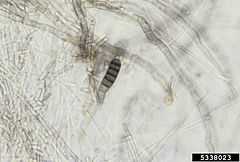Thielaviopsis
From Wikipedia, the free encyclopedia
| Thielaviopsis | |
|---|---|
 | |
| Microscopic view of Thielaviopsis chlamydospores (black) and endoconidia (hyaline) | |
| Scientific classification | |
| Kingdom: | Fungi |
| Division: | Ascomycota |
| Subdivision: | Pezizomycotina |
| Class: | Sordariomycetes |
| Order: | Microascales |
| Family: | Ceratocystidaceae |
| Genus: | Thielaviopsis |
| Species | |
| |
| Synonyms | |
|
Chalara | |
Thielaviopsis is a small genus of fungi in the order Microascales.[1] The genus includes several important agricultural pathogens. The most widespread is T. basicola, the causal agent in several root rot diseases of economically important crop species including cotton and a variety of vegetables. In cotton, Thielaviopsis root rot, also known as black root rot causes necrosis of the roots and stunting of the crop plants.
References
- ↑ "Thielaviopsis". National Center for Biotechnology Information. Retrieved 26 October 2012.
This article is issued from Wikipedia. The text is available under the Creative Commons Attribution/Share Alike; additional terms may apply for the media files.